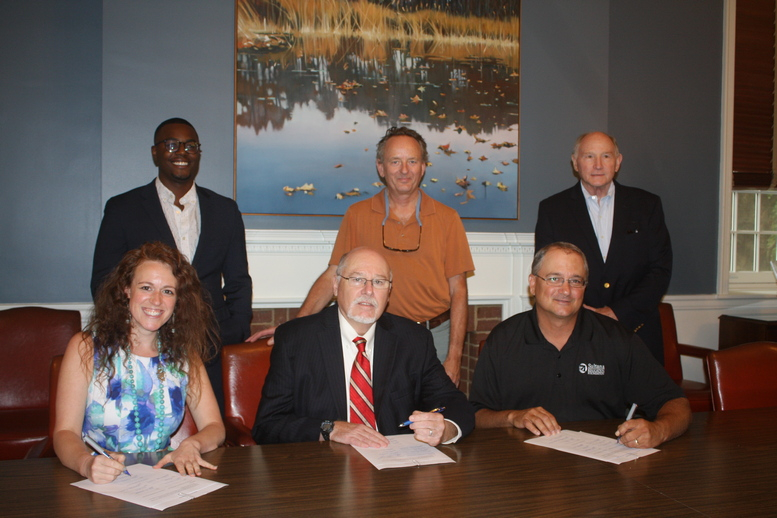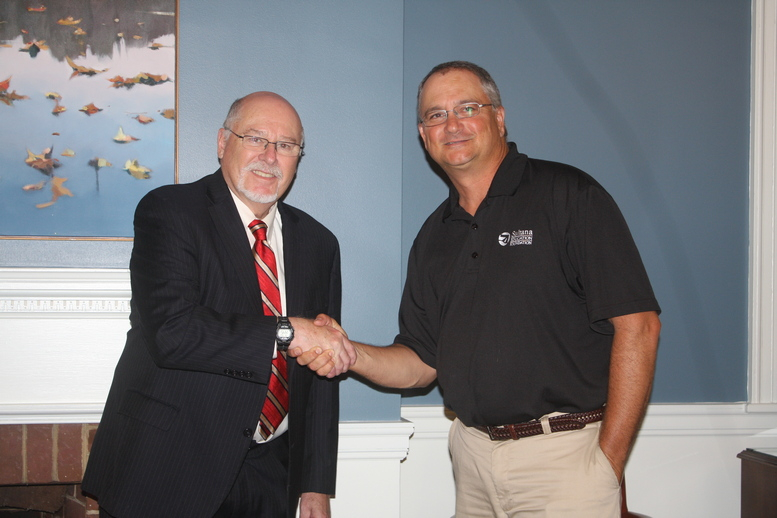
Katie Parks of Eastern Shore Land Conservancy. Washington College President Kurt Landgraf and Chestertown Mayor Chris Cerino sign a memorandum of understanding for a riverfront walkway across college lands. Watching (second row, L-R) are Darius Johnson of ESLC, Kees de Mooy, Chestertown zoning administrator, and Matthew Tobriner of Chestertown — photo by Jane Jewell
Chestertown’s long-planned riverfront walkway — tentatively named the Chestertown Heritage Trail — is one step closer to reality.
Mayor Chris Cerino, Washington College President Kurt Landgraf, and Katie Parks, Vice President for Conservation with Eastern Shore Land Conservancy, signed a memorandum of understanding spelling out the roles of the three entities in creating the walking path, which would cross the college lands along the Chester River. When completed, the path would create a pedestrian loop from the foot of High Street to the marina, across Wilmer Park and the college’s waterfront campus to the vicinity of Radcliffe Creek, returning to town along Cross Street extended. Cerino said the town would eventually like to connect the walkway to the Gilchrest Rail Trail, which currently ends just north of Cross Street near Wilmer Park. The trail would be open dawn to dusk, and would not be illuminated.

Washington College President Kurt Landgraf and Chestertown Mayor Chris Cerino shake hands — photo by Jane Jewell
After the signing, which took place in Landgraf’s offices on the college’s main campus Sept. 5, Cerino said the next steps are to create formal engineering plans “with a price tag,” to agree on easements across the college’s lands, and to embark on fundraising for the project. Landscape architect Miles Barnard of South Fork Studio, who has done numerous other projects in the area, is creating the designs.
Kees de Mooy, the town’s zoning administrator, said he expected the plans to be ready by the end of the year. If all goes smoothly, the walkway itself could be built by the end of 2020. He said there should be fairly easy to obtain grant funding for the “shovel-ready” project, in part because the college and ESLC are on board. The ESLC will be largely responsible for obtaining the grants and helping the town obtain the necessary environmental clearances.
The cost of the project was ballparked by one committee member at perhaps “a couple hundred thousand.” The final cost will depend primarily on the materials to be used; a proposed boardwalk across the marshy land between the armory and Radcliffe Creek would be the most expensive portion of the trail. The sections across drier land, which are primarily paved walks, would be the first to be built. Cerino said those areas could be paved with oyster shell or crushed concrete recycled from recently demolished buildings. Maintenance would be the town’s responsibility, according to the terms of the memorandum of agreement.
Also present at the signing were Darius Johnson of ESLC and Matthew Tobriner, who has been a member of several town boards on waterfront preservation and improvement, along with several members of Landgraf’s staff.



Write a Letter to the Editor on this Article
We encourage readers to offer their point of view on this article by submitting the following form. Editing is sometimes necessary and is done at the discretion of the editorial staff.